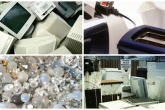Data protection fears could be holding back electronic recycling
Worries about how our personal data could be stolen and used are holding back the correct and sustainable disposal of broken and unused electronics, according to a recent survey.
69 per cent of those questioned by REPIC, the UK’s largest compliance scheme for waste electrical and electronic equipment (WEEE), admitted to having concerns about their personal data being breached, with a third saying that they were more likely to keep hold of old electricals as a consequence.

This, in addition to the fact that devices are getting smaller and smaller, could be why so many unused items are simply put to the back of a cupboard or relegated to a drawer rather than being recycled.
In 2015, environmental think tank Green Alliance estimated that there were up to 125 million smartphones lying unused in UK homes, despite the fact that, at the time (several models ago) parts of a discarded two-year-old iPhone could be worth up to £170 – nearly one third of the original sales value of the device.
Critical raw materials within electronic appliances are growing more and more scarce, making their recycling all the more important, but, according to WRAP, around two million tonnes of electrical and electronic equipment is placed on the market in the UK every year, with 1.53 million tonnes going to waste in 2015.
“Data can be deleted, devices cannot,” said REPIC CEO Mark Burrows-Smith. “These results are really telling in what drives people’s recycling behaviours and the need for increased education around how householders remove personal data before disposal.
“The Internet of Things means that connectivity is the norm and with more and more people synching their personal data to electronic devices, it is clear that there is a real risk that old or unused electricals are being stockpiled due to fear and miseducation.”
The REPIC survey found that around a quarter of respondents didn’t know how to delete their personal data, while it also revealed a generation gap highlighting the growing wariness of young people regarding their digital footprint. 76 per cent of 16-29 year olds were most worried about the security of their private information, while only 59 per cent of people aged 60 or over thought it was of any concern.
As well as the fears about data protection, however, the survey suggested that there is a growing awareness of how and when electronic equipment can be recycled. 21 per cent of respondents said that they had a ‘lack of knowledge’ of where to recycle electronic devices and gadgets, compared to 31 per cent in a separate REPIC poll in 2016.
Moreover, 17 per cent said that they were unaware that their devices could be recycled in the first place, compared to 28 per cent in 2016.
WEEE items can be taken to household waste recycling centres (HWRCs) for recycling, while some council’s offer kerbside collection for small appliances. The WEEE directive also means that all retailers must provide a way for customers to dispose of their old household electrical and electronic equipment when they sell them a new version of the same item, either through a collection service or a store take-back scheme.
“Despite the barriers to recycling, people in the UK are aware of the consequences and cite reducing waste sent to landfill as the key driver for achieving their recycling responsibilities,” added Burrows-Smith.
“Overall the results paint a an optimistic picture that attitudes and behaviours are moving in the right direction – yet, as always, it is clear from these findings and the issues the WEEE industry is facing, that we must adapt to changing consumer behaviours to ensure this continues on the right trajectory.”








